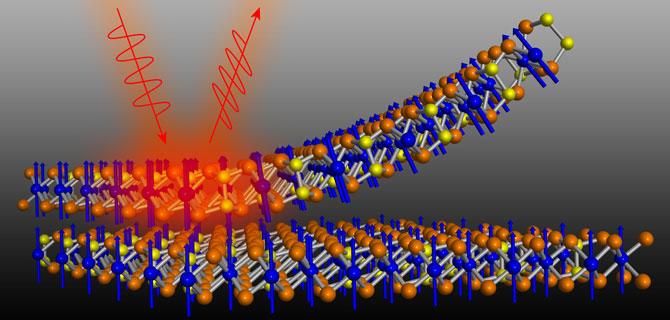
Credit: Zhenglu Li/Berkeley Lab
It may not seem like a material as thin as an atom could hide any surprises, but a research team led by scientists at the Department of Energy's Lawrence Berkeley National Laboratory (Berkeley Lab) discovered an unexpected magnetic property in a two-dimensional material.
The scientists found that a 2-D van der Waals crystal, part of a class of material whose atomically thin layers can be peeled off one by one with adhesive tape, possessed an intrinsic ferromagnetism.
The discovery, to be published April 26 in the journal Nature, could have major implications for a wide range of applications that rely upon ferromagnetic materials, such as nanoscale memory, spintronic devices, and magnetic sensors.
"This is an exciting discovery," said study principal investigator Xiang Zhang, senior faculty scientist at Berkeley Lab's Materials Sciences Division and UC Berkeley professor. "This experiment presents smoking-gun evidence for an atomically thin–and atomically flat–magnet, which surprised many people. It opens the door for exploring fundamental spin physics and spintronic applications at low dimensions."
The study tackles a long-standing issue in quantum physics about whether magnetism would survive when materials shrink down to two dimensions. For half a century, the Mermin-Wagner theorem has addressed this question by stating that if 2-D materials lack magnetic anisotropy, a directional alignment of electron spins in the material, there may be no magnetic order.
"Interestingly, we found that magnetic anisotropy is an inherent property in the 2-D material we studied, and because of this characteristic, we were able to detect the intrinsic ferromagnetism," said study lead author Cheng Gong, a postdoctoral researcher in Zhang's lab.
Van der Waals forces, named after a Dutch scientist, refers to intermolecular forces of attraction that do not arise from the typical covalent or ionic bonds that keep molecules intact. These quantum forces are used by geckos as they effortlessly scamper along walls and ceilings.
Van der Waals crystals describe materials in which the 2-D layers are not connected to each other via traditional bonds, allowing them to be easily exfoliated with tape. Research on graphene, the most well-known van der Waals material, earned the Nobel Prize in physics in 2010.
"It's like the pages of a book," said Gong. "The pages can be stacked on top of each other, but the forces linking one page to another is much weaker than the in-plane forces that keep a single sheet intact."
Gong estimates that for this study, he peeled off more than 3,000 flakes of chromium germanium telluride (Cr2Ge2Te6, or CGT). While CGT has existed as a bulk material for decades, the researchers say the 2-D flakes could represent an exciting new family of 2-D van der Waals crystal.
"CGT is also a semiconductor, and the ferromagnetism is intrinsic," said co-senior author Jing Xia, UC Irvine associate professor of physics and astronomy. "That makes it cleaner for applications in memory and spintronics."
The researchers detect the magnetization from atomically thin materials using a technique called magneto-optic Kerr effect. The method involves the super-sensitive detection of the rotation of linearly polarized light when it interacts with electron spins in the material.
The key to one of the study's more surprising findings is that the magnetic anisotropy was very small in the CGT material. That enabled researchers to easily control the temperature at which the material loses its ferromagnetism, known as the transition or Curie temperature.
"This is a significant discovery," said Gong, "People believe that the Curie temperature is an inherent property of a magnetic material and cannot be changed. Our study shows that it can."
The researchers showed that they could control the transition temperature of the CGT flake using surprisingly small magnetic fields of 0.3 tesla or less.
"Thin films of metals like iron, cobalt, and nickel, unlike 2-D van der Waals materials, are structurally imperfect and susceptible to various disturbances, which contribute to a huge and unpredictable spurious anisotropy," said Gong. "In contrast, the highly crystalline and uniformly flat 2-D CGT, together with its small intrinsic anisotropy, allows small external magnetic fields to effectively engineer the anisotropy, enabling an unprecedented magnetic field control of ferromagnetic transition temperatures."
The study authors also pointed out that a striking feature of van der Waals crystals is that they can be easily combined with dissimilar materials without restrictions based on structural or chemical compatibility.
"The opportunities to combine different materials to develop new functionalities are appealing," said co-senior author Steven Louie, senior faculty scientist at Berkeley Lab's Materials Sciences Division and UC Berkeley professor of physics. "This offers a huge amount of flexibility in designing artificial structures for diverse magneto-electric and magneto-optical applications."
###
Other senior collaborators on this work include Zi Qiang Qiu at Berkeley Lab and UC Berkeley; and Robert Cava at Princeton University.
This work was primarily supported by DOE's Office of Science.
Lawrence Berkeley National Laboratory addresses the world's most urgent scientific challenges by advancing sustainable energy, protecting human health, creating new materials, and revealing the origin and fate of the universe. Founded in 1931, Berkeley Lab's scientific expertise has been recognized with 13 Nobel Prizes. The University of California manages Berkeley Lab for the U.S. Department of Energy's Office of Science. For more, visit http://www.lbl.gov.
DOE's Office of Science is the single largest supporter of basic research in the physical sciences in the United States, and is working to address some of the most pressing challenges of our time. For more information, please visit science.energy.gov.
Media Contact
Sarah Yang
[email protected]
510-486-4575
@BerkeleyLab
############
Story Source: Materials provided by Scienmag





